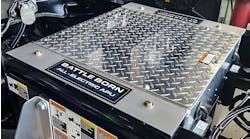The United States Department of Transportation’s Federal Motor Carrier Safety Administration (FMCSA) has announced the first substantial change to the hours-of-service rules (HOS) since 1939.
FMCSA plans to expand its research initiative on electronic onboard recorders and other technologies, including evaluating alternatives for encouraging or providing incentives for their use to ensure HOS recordkeeping and compliance.
The new rules allow drivers to drive 11 hours after 10 consecutive hours off-duty. Drivers may not drive beyond the 14th hour after coming on-duty, following 10 hours off-duty. They may not drive after being on-duty for 60 hours in a seven-consecutive-day period or 70 hours in an eight-consecutive-day period. This on-duty cycle may be restarted whenever a driver takes at least 34 consecutive hours off-duty.
Short-haul truck drivers—who routinely return to their place of dispatch after each duty tour and then are released from duty—may have an increased on-duty period of 16 hours once during any seven-consecutive-day period. The 16-hour exception takes into consideration legitimate business needs without jeopardizing safety. FMCSA estimates that without the extra two on-duty hours, the industry would be required to hire at least 48,000 new drivers.
The current rule allows 10 hours of driving within a 15-hour on-duty period after eight hours of off-duty time. Also, drivers may not drive after their 15th hour on duty in a workday or after 60 hours on-duty in seven consecutive days or 70 hours on-duty in eight consecutive days.
FMCSA estimates the new rule will save up to 75 lives and prevent as many as 1,326 fatigue-related crashes annually.
This rule governs drivers transporting freight in interstate commerce in a property-carrying commercial vehicle with a gross vehicle weight rating of 10,001 pounds or more, and operating vehicles transporting hazardous materials in quantities requiring vehicle placards.
Carriers will operate under current HOS regulations through Jan 3, 2004. Drivers of buses involved in interstate transportation will continue to use the current regulations.
FMCSA and its state enforcement partners will begin enforcing the final rule beginning Jan 4, 2004. The implementation plan provides time to modify computer systems to reflect regulatory changes, train more than 8,000 state and federal personnel, and provide education and outreach to the industry. In addition, the implementation plan allows carriers and drivers time to become familiar with the regulation and make any procedural changes necessary for compliance.
Rules for the record-of-duty status form, also known as a driver’s daily log, remain unchanged for truck and bus drivers. Truck and bus drivers operating within a 100-air-mile radius of the driver’s normal work location, who return to that location and are released from duty within 12 hours, will keep time cards as allowed under the current rules.


